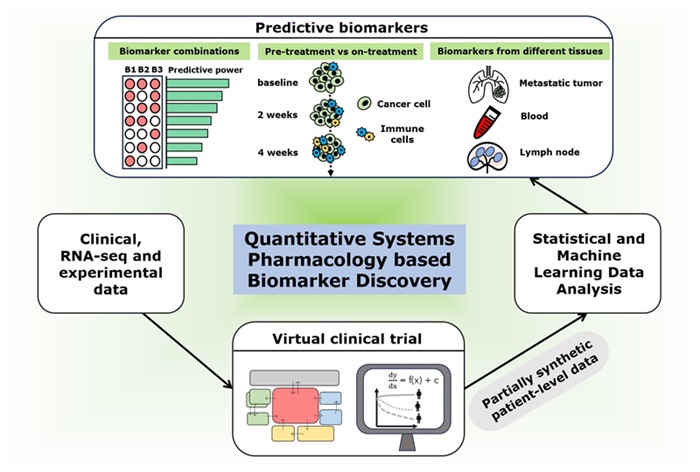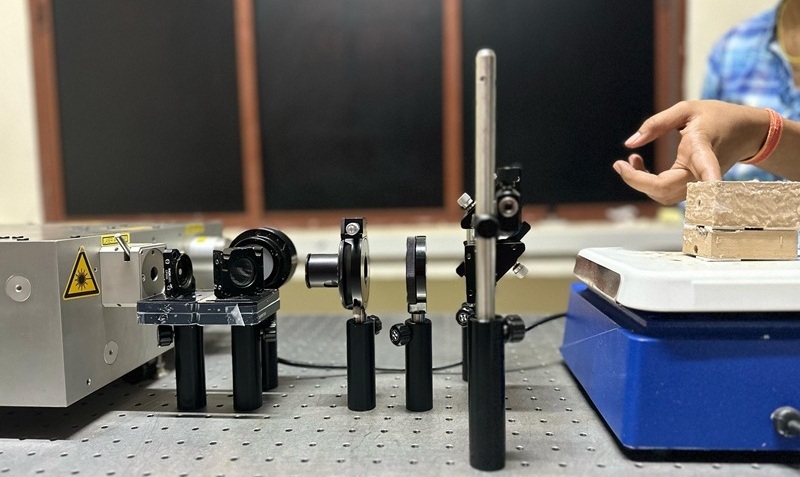Computational Tool Predicts Immunotherapy Outcomes for Metastatic Breast Cancer Patients
|
By LabMedica International staff writers Posted on 31 Oct 2024 |

Immunotherapy aims to enhance the body’s immune response to target cancer cells, but not all patients experience a positive reaction to such treatments. Identifying which patients will benefit from immunotherapy is crucial, given the high toxicity associated with these therapies. Previous research has investigated whether the presence or absence of specific cells or the expression levels of various molecules within tumors can indicate a patient's likelihood of responding to immunotherapy. These molecules, known as predictive biomarkers, play an important role in selecting appropriate treatments for patients. Unfortunately, the accuracy of current predictive biomarkers in determining who will benefit from immunotherapy is limited. Additionally, conducting a large-scale evaluation of the characteristics that predict treatment response typically requires collecting tumor biopsies and blood samples from numerous patients and performing several assays, which presents significant challenges. Researchers have now leveraged computational tools to create a method for assessing which patients with metastatic triple-negative breast cancer may benefit from immunotherapy.
A team of computational scientists from the Johns Hopkins Kimmel Cancer Center (Baltimore, MD, USA) and the Johns Hopkins University School of Medicine (Baltimore, MD, USA) utilized a mathematical model called quantitative systems pharmacology to generate 1,635 virtual patients with metastatic triple-negative breast cancer and conducted treatment simulations using the immunotherapy drug pembrolizumab. They analyzed this data with advanced computational tools, including statistical and machine learning methods, to identify biomarkers that can accurately predict treatment responses. Their focus was on determining which patients would respond positively to treatment and which would not. By utilizing the partially synthetic data generated from the virtual clinical trial, the researchers evaluated the performance of 90 biomarkers both individually and in combinations of two, three, and four.
The findings revealed that pretreatment biomarkers, which are measurements taken from tumor biopsies or blood samples before treatment begins, had limited effectiveness in predicting treatment outcomes. Conversely, on-treatment biomarkers, which are collected after the initiation of treatment, proved to be more predictive of outcomes. Interestingly, the study found that some commonly utilized biomarker measurements, such as the expression of PD-L1 and the presence of lymphocytes within the tumor, performed better when assessed before treatment commenced rather than after it started. The researchers also investigated the accuracy of non-invasive measurements, such as immune cell counts in the blood, in forecasting treatment outcomes. According to their research published in the Proceedings of the National Academy of Sciences, some blood-based biomarkers were found to be comparably effective as tumor- or lymph node-based biomarkers in identifying patients likely to respond to treatment, suggesting a less invasive predictive approach.
Measurements of changes in tumor size, which can be easily obtained through CT scans, also showed potential as predictive indicators. Notably, these measurements taken within two weeks of initiating treatment demonstrated significant potential in identifying who would respond favorably if the treatment continued. To confirm their findings, the investigators conducted a virtual clinical trial selecting patients based on tumor diameter changes at the two-week mark after starting treatment. Remarkably, the simulated response rates more than doubled—from 11% to 25%. This underscores the potential of noninvasive biomarkers as alternatives when collecting tumor biopsy samples is not feasible. Overall, these new insights highlight the possibility of better patient selection for immunotherapy in metastatic breast cancer cases. The researchers anticipate that these findings will aid in designing future clinical studies, with the methodology potentially applicable to other cancer types.
“Predictive biomarkers are critical as we develop optimized strategies for triple-negative breast cancer, so as to avoid overtreatment in patients expected to do well without immunotherapy, and undertreatment in those who do not respond well to immunotherapy,” said study co-author Cesar Santa-Maria, M.D., an associate professor of oncology and breast medical oncologist at the Johns Hopkins Kimmel Cancer Center. “The complexities of the tumor microenvironment make biomarker discovery in the clinic challenging, but technologies leveraging in-silico [computer-based] modeling have the potential to capture such complexities and aid in patient selection for therapy.”
Latest Immunology News
- Post-Treatment Blood Test Could Inform Future Cancer Therapy Decisions
- Cerebrospinal Fluid Test Predicts Dangerous Side Effect of Cancer Treatment
- New Test Measures Preterm Infant Immunity Using Only Two Drops of Blood
- Simple Blood Test Could Help Choose Better Treatments for Patients with Recurrent Endometrial Cancer
- Novel Analytical Method Tracks Progression of Autoimmune Diseases
- 3D Bioprinted Gastric Cancer Model Uses Patient-Derived Tissue Fragments to Predict Drug Response
- Blood Test for Fungal Infections Could End Invasive Tissue Biopsies
- Cutting-Edge Microscopy Technology Enables Tailored Rheumatology Therapies
- New Discovery in Blood Immune Cells Paves Way for Parkinson's Disease Diagnostic Test
- AI Tool Uses Routine Blood Tests to Predict Immunotherapy Response for Various Cancers
- Blood Test Can Predict How Long Vaccine Immunity Will Last
- Microfluidic Chip-Based Device to Measure Viral Immunity
- Simple Blood Test Could Detect Drug Resistance in Ovarian Cancer Patients
- Advanced Imaging Method Maps Immune Cell Connections to Predict Cancer Patients Survival
Channels
Clinical Chemistry
view channel
Carbon Nanotubes Help Build Highly Accurate Sensors for Continuous Health Monitoring
Current sensors can measure various health indicators, such as blood glucose levels, in the body. However, there is a need to develop more accurate and sensitive sensor materials that can detect lower... Read more
Paper-Based Device Boosts HIV Test Accuracy from Dried Blood Samples
In regions where access to clinics for routine blood tests presents financial and logistical obstacles, HIV patients are increasingly able to collect and send a drop of blood using paper-based devices... Read moreMolecular Diagnostics
view channel
Rapid Diagnostic Test to Halt Mother-To-Child Hepatitis B Transmission
Hepatitis B, an inflammation of the liver caused by the hepatitis B virus (HBV), is the second-leading infectious cause of death globally, following tuberculosis. This viral infection can result in serious... Read more
Simple Urine Test Could Help Patients Avoid Invasive Scans for Kidney Cancer
Clear cell renal cell carcinoma (ccRCC) is the most prevalent type of kidney cancer, making up approximately 90% of cases. Each year, around 400,000 individuals are diagnosed with ccRCC globally.... Read moreHematology
view channel
New Scoring System Predicts Risk of Developing Cancer from Common Blood Disorder
Clonal cytopenia of undetermined significance (CCUS) is a blood disorder commonly found in older adults, characterized by mutations in blood cells and a low blood count, but without any obvious cause or... Read more
Non-Invasive Prenatal Test for Fetal RhD Status Demonstrates 100% Accuracy
In the United States, approximately 15% of pregnant individuals are RhD-negative. However, in about 40% of these cases, the fetus is also RhD-negative, making the administration of RhoGAM unnecessary.... Read moreMicrobiology
view channel
Innovative ID/AST System to Help Diagnose Infectious Diseases and Combat AMR
Each year, 11 million people across the world die of sepsis out of which 1.3 million deaths are due to antibiotic-resistant bacteria. The burden of antimicrobial resistance (AMR) continues to weigh heavily,... Read more
Gastrointestinal Panel Delivers Rapid Detection of Five Common Bacterial Pathogens for Outpatient Use
Acute infectious gastroenteritis results in approximately 179 million cases each year in the United States, leading to a significant number of outpatient visits and hospitalizations. To address this, a... Read morePathology
view channel
Powerful AI Tool Diagnoses Coeliac Disease from Biopsy Images with Over 97% Accuracy
Coeliac disease is an autoimmune disorder triggered by the consumption of gluten, causing symptoms such as stomach cramps, diarrhea, skin rashes, weight loss, fatigue, and anemia. Due to the wide variation... Read more
Pre-Analytical Conditions Influence Cell-Free MicroRNA Stability in Blood Plasma Samples
Scientists worldwide are working to enhance the quality of diagnostics and prognosis for various diseases, including cancer, by analyzing different body fluids such as blood, urine, and saliva.... Read more
3D Cell Culture System Could Revolutionize Cancer Diagnostics
New drugs and diagnostic methods should ideally be both safe and quickly accessible, but the preclinical testing phase often hinders rapid progress due to the high level of resources it requires.... Read more
Painless Technique Measures Glucose Concentrations in Solution and Tissue Via Sound Waves
Blood glucose levels are traditionally measured using invasive methods that require pricking the skin with small needles. However, for individuals with diabetes, frequent testing throughout the day becomes... Read moreTechnology
view channel
Smartphones Could Diagnose Diseases Using Infrared Scans
Rapid advancements in technology may soon make it possible for individuals to bypass invasive medical procedures by simply uploading a screenshot of their lab results from their phone directly to their doctor.... Read more
Novel Sensor Technology to Enable Early Diagnoses of Metabolic and Cardiovascular Disorders
Metabolites are critical compounds that fuel life's essential functions, playing a key role in producing energy, regulating cellular activities, and maintaining the balance of bodily systems.... Read more
3D Printing Breakthrough Enables Large Scale Development of Tiny Microfluidic Devices
Microfluidic devices are diagnostic systems capable of analyzing small volumes of materials with precision and speed. These devices are used in a variety of applications, including cancer cell analysis,... Read moreIndustry
view channel
Philips and Ibex Expand Partnership to Enhance AI-Enabled Pathology Workflows
Royal Philips (Amsterdam, The Netherlands) has expanded its partnership with Ibex Medical Analytics (Tel Aviv, Israel) and released the new Philips IntelliSite Pathology Solution (PIPS) to further accelerate... Read more
Grifols and Inpeco Partner to Deliver Transfusion Medicine ‘Lab of The Future’
Grifols (Barcelona, Spain), a manufacturer of plasma-derived medicines and innovative diagnostic solutions, has entered into a strategic agreement with Inpeco (Novazzano, Switzerland), a global leader... Read more






















